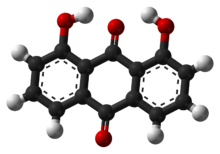- 1,8-Dihydroxyanthraquinone
-
1,8-Dihydroxyanthraquinone 

Systematic (IUPAC) name 1,8-dihydroxyanthracene-9,10-dione Clinical data Pregnancy cat. ? Legal status ? Routes Oral, rectal (enema) Identifiers CAS number 117-10-2 
ATC code A06AB03 A06AB53 A06AG03 PubChem CID 2950 DrugBank DB04816 ChemSpider 2845 
UNII Z4XE6IBF3V 
KEGG D07107 
ChEBI CHEBI:3682 
ChEMBL CHEMBL53418 
Chemical data Formula C14H8O4 Mol. mass 240.211 g/mol SMILES eMolecules & PubChem  (what is this?) (verify)
(what is this?) (verify)1,8-Dihydroxyanthraquinone is an organic substance with formula C14H8O4, formally derived from anthraquinone by the replacement of two hydrogen atoms by hydroxyl groups (OH). It is used in some countries as a stimulant laxative, under the generic names dantron or chrysazin.
It should not be confused with ondansetron, an unrelated drug that was marketed in South Africa uder the trade name "Dantron".
Medical uses
In the USA, dantron is not used because it is considered to be a carcinogen.[1]
In the UK it is considered a possible carcinogen and so its licence is restricted to patients who already have a diagnosis of terminal cancer (i.e. it is mainly used in palliative care to counteract the constipating effects of opioids) Its British Approved Name was Danthron, but it has now been changed to "dantron", the recommended International Nonproprietary Name.[2]
Dantron has the notable side-effect of causing red-coloured urine.
See also
- Hydroxyanthraquinone
- Rhein (molecule)
References
- ^ Danthron substance profile at the National Toxicology Program website
- ^ British National Formulary website (requires free registration)
Laxatives and cathartics (A06) Softeners, emollients Contact laxatives Oxyphenisatine • Bisacodyl • Dantron • Phenolphthalein • Castor oil • Senna glycosides • Cascara • Sodium picosulfate • BisoxatinBulk producers Osmotically acting laxatives Magnesium carbonate • Magnesium hydroxide • Magnesium oxide • Magnesium peroxide • Magnesium sulfate • Lactulose • Lactitol • Sodium sulfate • Pentaerythritol • Macrogol • Mannitol • Sodium phosphate • Sorbitol • Magnesium citrate • Sodium tartrate • Laminarid • Polyethylene glycol;Enemas Peripheral opioid antagonists Prostaglandins Categories:- IARC Group 2B carcinogens
- Laxatives
- Dihydroxyanthraquinones
Wikimedia Foundation. 2010.
